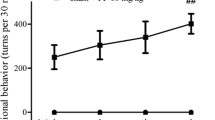Abstract
The catecholaminergic neurotoxin 6-hydroxydopamine has been widely used to mimic the lesions in dopaminergic neurons to develop Parkinson’s disease. The present study was aimed to evaluate the combined treatment with Curcumin and desferrioxamine (DFO) on 6-OHDA- induced neurotoxicity in the striatum of rats. Rat models with 6-OHDA-induced Parkinson’s disease were treated with curcumin, DFO, or both and the effect of different treatments on dopamine level was examined. Moreover, the effect of different treatments on the levels of PCC, SOD, and GSH was also assessed to elucidate the underlying mechanisms of the neuroprotective effects of combined treatment of curcumin and DFO.





Similar content being viewed by others
References
Sowell, R. A., Owen, J. B., & Butterfield, D. A. (2009). Proteomics in animal models of Alzheimer’s and Parkinson’s diseases. Ageing Research Reviews, 8(1), 1–17.
Klockgether, T. (2004). Parkinson’s disease: Clinical aspects. Cell and Tissue Research, 318(1), 115–120.
Patt, S., et al. (1991). Pathological changes in dendrites of substantia nigra neurons in Parkinson’s disease: A Golgi study. Histology and Histopathology, 6(3), 373–380.
Sauer, H., & Oertel, W. H. (1994). Progressive degeneration of nigrostriatal dopamine neurons following intrastriatal terminal lesions with 6-hydroxydopamine: A combined retrograde tracing and immunocytochemical study in the rat. Neuroscience, 59(2), 401–415.
Singh, M. P., et al. (2006). Contribution of genomics and proteomics in understanding the role of modifying factors in Parkinson’s disease. Indian Journal of Biochemistry & Biophysics, 43(2), 69–81.
Ambani, L. M., Van Woert, M. H., & Murphy, S. (1975). Brain peroxidase and catalase in Parkinson disease. Archives of Neurology, 32(2), 114–118.
Aggarwal, B. B., et al. (2007). Curcumin: The Indian solid gold. Advances in Experimental Medicine and Biology, 595, 1–75.
Mutsuga, M., et al. (2012). Binding of curcumin to senile plaques and cerebral amyloid angiopathy in the aged brain of various animals and to neurofibrillary tangles in Alzheimer’s brain. Journal of Veterinary Medical Science, 74(1), 51–57.
Mythri, R. B., et al. (2011). Glutamoyl diester of the dietary polyphenol curcumin offers improved protection against peroxynitrite-mediated nitrosative stress and damage of brain mitochondria in vitro: Implications for Parkinson’s disease. Molecular and Cellular Biochemistry, 347(1–2), 135–143.
Mansouri, A., & Perry, C. A. (1982). Alteration of platelet aggregation by cigarette smoke and carbon monoxide. Thrombosis and Haemostasis, 48(3), 286–288.
Lee, W. H., et al. (2013). Curcumin and its derivatives: Their application in neuropharmacology and neuroscience in the 21st century. Current Neuropharmacology, 11(4), 338–378.
Guelman, L. R., et al. (2004). Deferoxamine antioxidant activity on cerebellar granule cells gamma-irradiated in vitro. Neurotoxicology and Teratology, 26(3), 477–483.
Nakamura, T., et al. (2004). Deferoxamine-induced attenuation of brain edema and neurological deficits in a rat model of intracerebral hemorrhage. Journal of Neurosurgery, 100(4), 672–678.
Okauchi, M., et al. (2009). Effects of deferoxamine on intracerebral hemorrhage-induced brain injury in aged rats. Stroke, 40(5), 1858–1863.
Weinreb, O., et al. (2013). Targeting dysregulation of brain iron homeostasis in Parkinson’s disease by iron chelators. Free Radical Biology & Medicine, 62, 52–64.
Haleagrahara, N., Siew, C. J., & Ponnusamy, K. (2013). Effect of quercetin and desferrioxamine on 6-hydroxydopamine (6-OHDA) induced neurotoxicity in striatum of rats. Journal of Toxicological Sciences, 38(1), 25–33.
Ellenbroek, B. A., et al. (1987). The paw test: A behavioural paradigm for differentiating between classical and atypical neuroleptic drugs. Psychopharmacology (Berl), 93(3), 343–348.
Richardson, J. R., et al. (2006). Developmental exposure to the pesticide dieldrin alters the dopamine system and increases neurotoxicity in an animal model of Parkinson’s disease. FASEB J, 20(10), 1695–1697.
Cicchetti, F., Drouin-Ouellet, J., & Gross, R. E. (2009). Environmental toxins and Parkinson’s disease: What have we learned from pesticide-induced animal models? Trends in Pharmacological Sciences, 30(9), 475–483.
Uversky, V. N. (2004). Neurotoxicant-induced animal models of Parkinson’s disease: Understanding the role of rotenone, maneb and paraquat in neurodegeneration. Cell and Tissue Research, 318(1), 225–241.
He, Y., Lee, T., & Leong, S. K. (2000). 6-Hydroxydopamine induced apoptosis of dopaminergic cells in the rat substantia nigra. Brain Research, 858(1), 163–166.
Singh, A., Naidu, P. S., & Kulkarni, S. K. (2003). Quercetin potentiates L-Dopa reversal of drug-induced catalepsy in rats: Possible COMT/MAO inhibition. Pharmacology, 68(2), 81–88.
Cannon, J. R., & Greenamyre, J. T. (2010). Neurotoxic in vivo models of Parkinson’s disease recent advances. Progress in Brain Research, 184, 17–33.
Deumens, R., Blokland, A., & Prickaerts, J. (2002). Modeling Parkinson’s disease in rats: An evaluation of 6-OHDA lesions of the nigrostriatal pathway. Experimental Neurology, 175(2), 303–317.
Zbarsky, V., et al. (2005). Neuroprotective properties of the natural phenolic antioxidants curcumin and naringenin but not quercetin and fisetin in a 6-OHDA model of Parkinson’s disease. Free Radical Reseach, 39(10), 1119–1125.
Ben-Shachar, D., et al. (1991). The iron chelator desferrioxamine (Desferal) retards 6-hydroxydopamine-induced degeneration of nigrostriatal dopamine neurons. Journal of Neurochemistry, 56(4), 1441–1444.
Yuan, W. J., et al. (2008). Neuroprotective effects of edaravone-administration on 6-OHDA-treated dopaminergic neurons. BMC Neuroscience, 9, 75.
Reiter, R. J. (1998). Oxidative damage in the central nervous system: Protection by melatonin. Progress in Neurobiology, 56(3), 359–384.
Wang, J., et al. (2009). Curcumin attenuates 6-hydroxydopamine-induced cytotoxicity by anti-oxidation and nuclear factor-kappa B modulation in MES23.5 cells. Biochemical Pharmacology, 78(2), 178–183.
Tripanichkul, W., & Jaroensuppaperch, E. O. (2013). Ameliorating effects of curcumin on 6-OHDA-induced dopaminergic denervation, glial response, and SOD1 reduction in the striatum of hemiparkinsonian mice. European Review for Medical and Pharmacological Sciences, 17(10), 1360–1368.
Author information
Authors and Affiliations
Corresponding author
Rights and permissions
About this article
Cite this article
Lv, H., Liu, J., Wang, L. et al. Ameliorating Effects of Combined Curcumin and Desferrioxamine on 6-OHDA-Induced Rat Mode of Parkinson’s Disease. Cell Biochem Biophys 70, 1433–1438 (2014). https://doi.org/10.1007/s12013-014-0077-3
Published:
Issue Date:
DOI: https://doi.org/10.1007/s12013-014-0077-3




